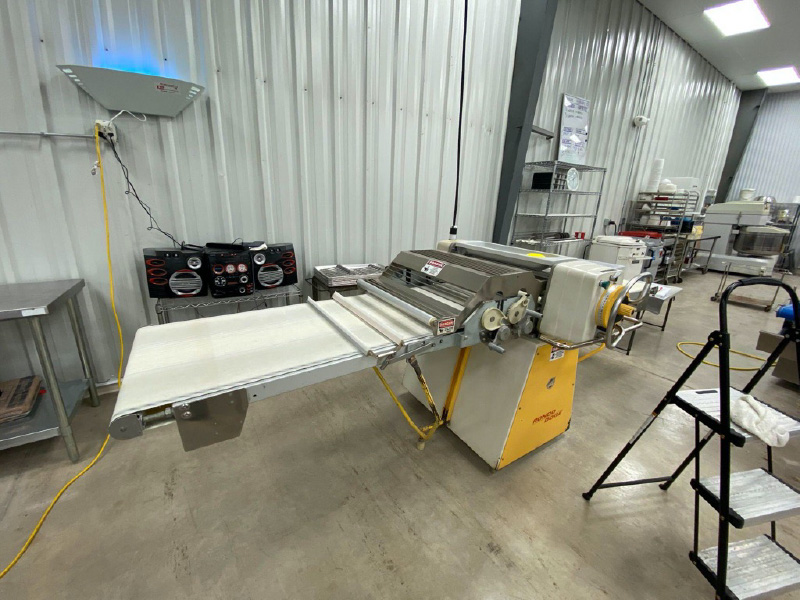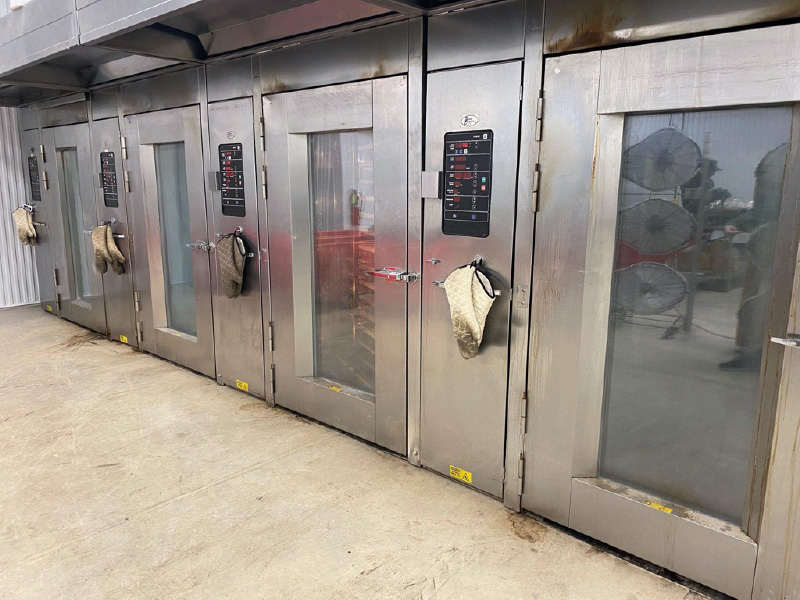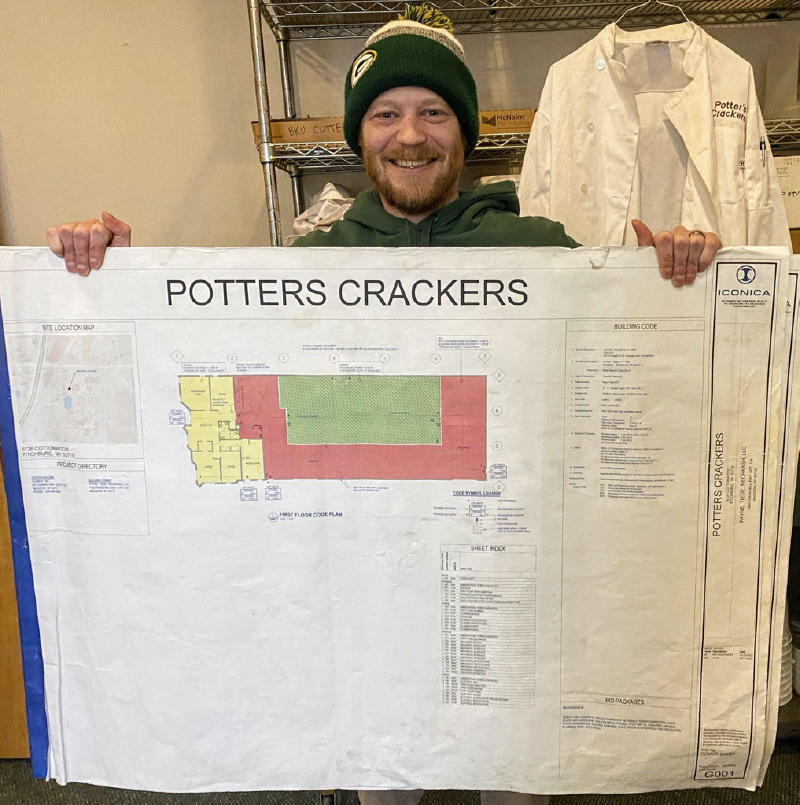by Melissa Reiss, Purchasing Assistant
Click on the photo thumbnails to see larger versions.
Over the hustle and bustle of the holiday season of 2022, Potter’s Crackers was extra busy moving their whole operation across town without skipping a beat in supplying us with the crackers we know and love. A long-time resident of the eastside’s Madison Enterprise Center, they tripled their footprint with an existing 12,000 square foot warehouse just south of the beltline in Fitchburg.
Owners David and Ashley Payne designed the interior themselves, retrofitting it to their needs. It includes a 5,000+ square-foot kitchen, 2,000 square-feet of offices, and another 2,000 square-foot mezzanine with natural light for product photography as well as extra storage space.
Now that they are a little more settled, I took a tour of their new facility. When I got out of my car, I knew I was at the right spot, as I was greeted by the smell of roasting onions.
Inside, I met up with David, who showed me around. The new space is a drastic improvement to the flow—resembling an horseshoe. There was a lot of criss-crossing in the previous space.
Dry Storage
 Their new pantry is five times larger, therefore they are able to buy raw ingredients in larger quantities.
Their new pantry is five times larger, therefore they are able to buy raw ingredients in larger quantities.
Also in the picture (which you can click on to see a larger version), you get a glimpse of one of their biggest investments in the new space—the air. The ducts near the ceiling are part of their air make-up unit, which exchanges the air in the kitchen every thirty minutes. “A building really has to breathe in production,” explains David, “especially when you’re combusting and exhausting.”
Combusting occurs through the ovens, and exhausting through the hoods and the dishwasher. If you don’t replace that air, it can be a health hazard. It also affects the actual production—temperature and air humidity affect flour performance.
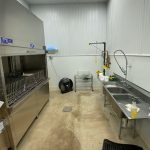 Future plans include a rooftop HVAC unit in order to air condition and further control humidity. Flour and other raw ingredients will then perform the same way regardless of the season. And I’m sure the bakers will too—imagine long, hot days in the old kitchen—baking crackers in the summer without air conditioning!
Future plans include a rooftop HVAC unit in order to air condition and further control humidity. Flour and other raw ingredients will then perform the same way regardless of the season. And I’m sure the bakers will too—imagine long, hot days in the old kitchen—baking crackers in the summer without air conditioning!
Sanitation Station
Inside the kitchen we go. Another big investment sits in their sanitation corner. They purchased a large capacity dishwasher that can wash up to 36 pans every four minutes. Previous to this, they washed everything by hand in sinks, so this is a huge game-changer!
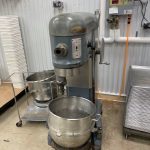
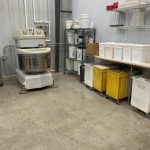 Sir Mix-A-Lot
Sir Mix-A-Lot
Here we have their two mixing stations, with mixers named Biggie (on the right) and Smalls (on the left). Generally, Biggie is used for their line of crisps. Smalls is their original Hobart mixer that Nancy and Peter Potter started the company with in 2006. Biggie is the style of mixer that is the way of the future, and they will look at adding another one at some point. However, they will always keep Smalls around to honor their beginnings, even if it eventually gets replaced in production.
The big improvement with the mixing stations is the addition of water meters hooked up to each one. Notice it on the wall next to Smalls. These meters siphon in water, simultaneously filtering and controlling the temperature. Prior to the meters, they had to manually fill buckets of water, weigh them out, and haul them over to the machine.
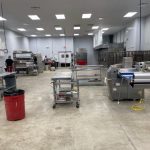 Let It Flow
Let It Flow
From here, their production flow is designed into three lines.
Their final big investment came over recently from Europe. David and Ashley traveled to Germany to order a customized machine that cuts the crackers and places them on trays to be baked. Before the machine, they would cut each tray of crackers by hand, one tray at a time, hundreds and hundreds of times per day. This new machine will handle a 30-foot dough band, cutting and dropping the crackers onto trays. “This machine essentially turns an eight-hour cracker day into a one-hour cracker day at its fastest, although it will take a little while to get there,” David explains.
 The machine arrived in February, and part of the calibration process involved people from the German company coming to Madison to help set up and tweak the machine.
The machine arrived in February, and part of the calibration process involved people from the German company coming to Madison to help set up and tweak the machine.
Let’s Cook
Potter’s Crackers started with ovens that fit five trays each. They now have four ovens that fit 40 trays each. Theoretically, every 20 minutes they can crank out 160 trays.
The hardest part of the move was getting these new ovens in place, which David and his team did themselves.
 Go Pack
Go Pack
Each container of Potter’s Crackers is still weighed, sealed, and packed by hand. That part hasn’t changed. Their packing department is split into Zone 1: weighing and sealing bags; and Zone 2: outside the kitchen where they are placed into their trays and finished off with the label sleeves.
They then sit briefly in the warehouse, ready to be sent off to natural food stores, specialty markets, and food co-ops around the country. They have shipped to all 50 states, but are consistently shipping out to between 30 to 40. They have gained a large following in California and Texas.
 However, the majority stay right here in town to be enjoyed by us locals—Willy Street Co-op is one of their top three largest accounts. The Potter’s crew is very thankful to all of you loyal customers here in Madison.
However, the majority stay right here in town to be enjoyed by us locals—Willy Street Co-op is one of their top three largest accounts. The Potter’s crew is very thankful to all of you loyal customers here in Madison.
Which—speaking of local—another thing that hasn’t changed is their dedication to using high-quality and local, when possible, ingredients, as a cracker company that cut their teeth selling at area farmers’ markets.
It’s clear that the owners and staff of Potter’s Crackers are passionate about what they do, while keeping it a local, family-owned business. With their expansion, they are excited to continue to achieve their dream of being a staple in the Wisconsin cracker landscape.

